Hot off the scanner, I present to you what is--to the best of my knowledge--the first English-language exposé on Marlene Dietrich's lesbian affairs, "The Untold Story of Marlene Dietrich" by Kenneth G. McLain, from the July 1955 issue of Confidential magazine.
Within that Mondrian abortion of a cover, McLain name-drops Claire Waldoff, Mercedes de Acosta, Frederique "Frede" Baule, and Jo Carstairs. Long before The National Enquirer and Perez Hilton, Confidential's Lavender Scare-era gossip threatened to tarnish the careers of "closeted" celebs, but not Marlene's! Those silly McCarthyists must not have known that Dietrich looked good in any color and that men's clothes were especially becoming on her. Nevertheless, it is dreadfully discomforting to recognize that the homophobic sport of outing is something of an American pastime.
If you were to tell me that another Mc--Diana McLellan--listed this article in the references of The Girls: Sappho Goes to Hollywood with ten pages of "Ibid." after it, I would have believed you. I have to give McLellan some credit, though. It appears that she only cited this rag a few times.
Below I have transcribed the article (not the photo captions, though--sorry!) for you as well as uploaded image files of the article. As you'll see, there are no photos of Marlene with any of these alleged lovers, but the Confidential staff more than made up for it with shots of the most burly babes in Marlene's harem and of lovers Gabin and Remarque making perplexed faces. Also, notice that only Frede squawked. Who are the unnamed others who sold out Marlene? Any guesses?
---
Within that Mondrian abortion of a cover, McLain name-drops Claire Waldoff, Mercedes de Acosta, Frederique "Frede" Baule, and Jo Carstairs. Long before The National Enquirer and Perez Hilton, Confidential's Lavender Scare-era gossip threatened to tarnish the careers of "closeted" celebs, but not Marlene's! Those silly McCarthyists must not have known that Dietrich looked good in any color and that men's clothes were especially becoming on her. Nevertheless, it is dreadfully discomforting to recognize that the homophobic sport of outing is something of an American pastime.
If you were to tell me that another Mc--Diana McLellan--listed this article in the references of The Girls: Sappho Goes to Hollywood with ten pages of "Ibid." after it, I would have believed you. I have to give McLellan some credit, though. It appears that she only cited this rag a few times.
Below I have transcribed the article (not the photo captions, though--sorry!) for you as well as uploaded image files of the article. As you'll see, there are no photos of Marlene with any of these alleged lovers, but the Confidential staff more than made up for it with shots of the most burly babes in Marlene's harem and of lovers Gabin and Remarque making perplexed faces. Also, notice that only Frede squawked. Who are the unnamed others who sold out Marlene? Any guesses?
---
THE UNTOLD STORY OF MARLENE DIETRICH
Her very first success on the stage was singing a strange love song--from one girl to another. But her boy friends really flipped when she actually started living up to the lyrics!
By Kenneth G. McLain
Marlene and men are an old story. She's been decorating picture pages with them for more than a quarter of a century--dozens of them, from John Gilbert to Ernest Hemingway.
And although she's been married to the same man since she was 21, Dietrich's never bothered to deny or hush the gossip about herself and her guys. It's more likely she wanted it that way--to cover up some sprightlier capers that would have lifted the nations eyebrows all the way up its forehead. Because in the millions of words that have been written about Dietrich's dalliances you've never, until now, read that some of them were not with men!
Tip-Off Appeared in Her First Stage Success
Dietrich going for dolls? Her adoring fans the world over will shriek, "Impossible!" It's the truth, though. In the game of amour, she's not only played both sides of the street, but done it on more than one occasion.
Ironically, her first stage success carried a prediction of such unusual hankerings. When the musical comedy "It's In The Air" opened in Berlin back in 1927, it featured a husky-voiced and unknown Miss Dietrich who stopped the show every night when she warbled a frankly Lesbian song to the leading lady, a flashing-eyed wench named Margo Lion.
"My Best Girl Friend" was the title of the ditty and, in time, all of Berlin turned out to hear Marlene sing, with gestures, about how Margo's charms lit a flame of desire in her heart.
Deviates singing of their strange love in public was the kind of thing that could only happen in Berlin after World War I. All through the roaring twenties, the German capital was a global headquarters for the most shameless perversions. Its streets were crammed with nighteries for the odd and their owners were so strict that a normal person was denied admission. Girls making like boys was of such little concern that the gossip columns regularly noted such cavortings as nonchalantly as they recorded the more usual affairs.
Whether Marlene and Margo carried their "Best Girl" bit beyond the footlights isn't known, but the fact that Dietrich would succumb to a dame became common knowledge in Berlin a year later, when Marlene happened to catch the eyes of Claire Waldoff, a blonde Amazon, who had become the toast of Germany's supper clubs for her skill with a risque song and a naughty story.
Claire Waldoff was notorious for her preference in playmates. It was her view that it was nuts to have a man around the house and she made no secret of it.
What was more of a mystery was why she chose Dietrich. For in those days Marlene was far from the glamorous creature who wowed 'em in Las Vegas with that transparent bodice. "It's In The Air" had closed and Dietrich was barely earning eating money as a hefty, 150-pound chorus hoofer with frizzy blonde hair and so little talent that she used to kick her own ankles black and blue.
Claire was old enough to be Dietrich's mother, but had different ideas. The pair became inseparables about the time that Marlene also met and enchanted a bushy-haired movie director with a handle-bar mustache named Josef von Sternberg. Under his direction, she made the film classic, "Blue Angel," and was hustled off to America to make another movie, "Morocco."
Absence Never Bothered Marlene
Von Sternberg's iron rule was tough enough to make Dietrich shed 30 pounds--but not Claire. She and Marlene were still such an item that when "Morocco" was premiered in Berlin and Dietrich went to the opening night, a sassy tabloid, the Berlin Herald, publicly lamented that Waldoff was out of town, thus depriving the girls of a chance to get together for a reunion clambake.
Such absences never have bothered Marlene, however, and didn't then. She just crossed the street--back to the boys. This time it was Igo Sym, the German comedian who incidentally taught her to play the musical saw, an act with which Marlene entertained our GIs during World War II. His course of instructions must have covered other grounds as well, because Dietrich permanently dropped Claire Waldoff and stuck to playing with the boys until well into the middle thirties. But von Sternberg, John Gilbert, Doug Fairbanks Jr., and half a dozen other assorted dandies fully realized that Marlene was an uninhibited product of a sophisticated post-war Europe. For instance, she'd been in Hollywood only two or three years when she picked up with Mercedes d'Acosta, a writer who favored clothes that seemed to be tailored by Brooks Brothers.
Mercedes had been the companion of other Hollywood double-standard dollies and fitted neatly into Marlene's pattern. But this was the U.S.A., where publicity on such capers would have raised a storm, so the girls discreetly limited themselves to quiet get-togethers at each other's house. At parties, they were the acme of propriety.
She Still Talks about That Night
In fact, Dietrich wasn't really flamboyant in the girl-meets-girl department again until the fall of 1936, when she made a trip to Paris to attend the opening of a new Maurice Chevalier musical at the Casino de Paris.
Men were clustering around her like flies around a honey pot at the time. Chevalier himself was vowing life wouldn't be worth the candle unless she'd be his--exclusively, that is. Still another swain was Erich Maria Remarque, the author of "All Quiet on the Western Front."
Ironically, Remarque upset the apple cart with his own hand by bringing to the Chevalier show a slim, brown-eyed girl, 20 years old and yearning to learn all about life. Frede was her name and she was destined to become the queen of Paris' Lesbians. She still talks of that opening night.
"It was wonderful to see so many well-known people," she says. "After the show we went to a reception for the star and there it happened--the time of my life."
By that she meant Dietrich. Until that night, the gals in Marlene's life had always been older--and the aggressors as well. It was time, though, for a new switch. Now in her middle thirties--a good 15 years older than Frede--she hypnotized the younger girl with her sophistication and her breath-taking clothes.
Over a skin-tight evening gown, Marlene wore a fur coat made of 32 white foxes that night. On her wrist was a curious bracelet, a snake-like gold band which twisted around the back of her hand and ended in a raised head, coiled on her forefinger. Dietrich confided to the younger girl that she wore it to discourage the number of men who wanted to kiss her hand.
The binge lasted for hours and--when it was over--Remarque got the shock of his life. He watched open-mouthed, as Marlene--his old girl--took Frede--his new date--home with her to the swank Lancaster Hotel on the Rue de Berri.
Off and on, the two women were to spend most of the next two and a half years together and their friendship was the talk of Paris. As her career demanded, Marlene would make flying trips to the United States, but she always returned to the French capital--and Frede. The younger woman was captivated. "Marlene was a marvelous woman," Frede unabashedly recalls, "I was just a kid and she could make me do anything she wanted. But she was always kind and generous. She was incomparable."
Even Frede may never have known that Marlene was also a two-timer. Not with men. In Frede's book, that sort of side-winding was permissible in a girl friend. She knew, for example, that Dietrich had continued a sizzling friendship with the French movie idol Jean Gabin during the same period.
What used to baffle Frede, however, was that Marlene would suddenly leave town for quick trips for fashionable resorts in the little villages strung out along Cap d'Antibes, near glamorous Cannes. Invariably, Marlene would insist on making the journey alone. What had happened on these occasions was that Marlene had gotten word that still another mannish maiden, Jo Carstairs, was available for diversion.
For the uninitiated, Jo is a Queen in more ways than one. A millionairess many times over, she owns a sun-splattered island in the Bahamas, Whale Cay, where she rules some 750 natives with an iron hand. Her favorite garb is a pair of dungarees and a man's shirt. She's been known to take strong measures against men who make advances toward her, since she prefers to make the overtures herself--and not to males.
Before the outbreak of World War II, Queen Jo used to enjoy loading her ocean-going yacht with steaks and champagne and setting off for Europe. The No. 1 stop on the continent was a little known bay, the harbor of Villefranche, near Cap d'Antibes.
Notified by cable, Marlene would be on hand and would be driven in a private limousine to the dock at Villefranche, where she would be rowed out for cozy weekends on Jo's yacht.
These naughty nautical adventures may come as a painful shock to Frede. On the other hand, she had nothing to complain about. Back in '38, while Marlene was alternating between Jo and Frede, the latter bashfully suggested that she'd like to go into business. Frede and Marlene put their heads together and decided the best venture would be a nightclub, catering to dolls as uninhibited as they were.
Dietrich was the behind-the-scenes backer when Frede opened a rollicking spot known as "La Silhouette." It did so well that, after World War II, Frede was able to buy an even flossier place, "Carroll's." On opening night, Marlene was resplendently present and contributed to the gayety. Remarque was there, too. So was Jean Gabin. Aslo Chevalier.
They were a worldly-wise trio, but had they started comparing notes on Marlene, even they might have been confused. For sharing their friendship with her was Frede, their hostess of the evening, Jo Carstairs, lurking off Cap d'Antibes, Claire Waldoff in Berlin. Back in Hollywood, too, there was Mercedes d'Acosta, Cary Grant, Jimmy Stewart and Gary Cooper. All these--and a husband, too!
What had the boys mumbling in their cognac was the big jackpot question: How does Dietrich do it?
There can be only one answer. The very contradictions which add up to Marlene Dietrich are best summed up in Frede's own words: Marlene is "incomparable!"

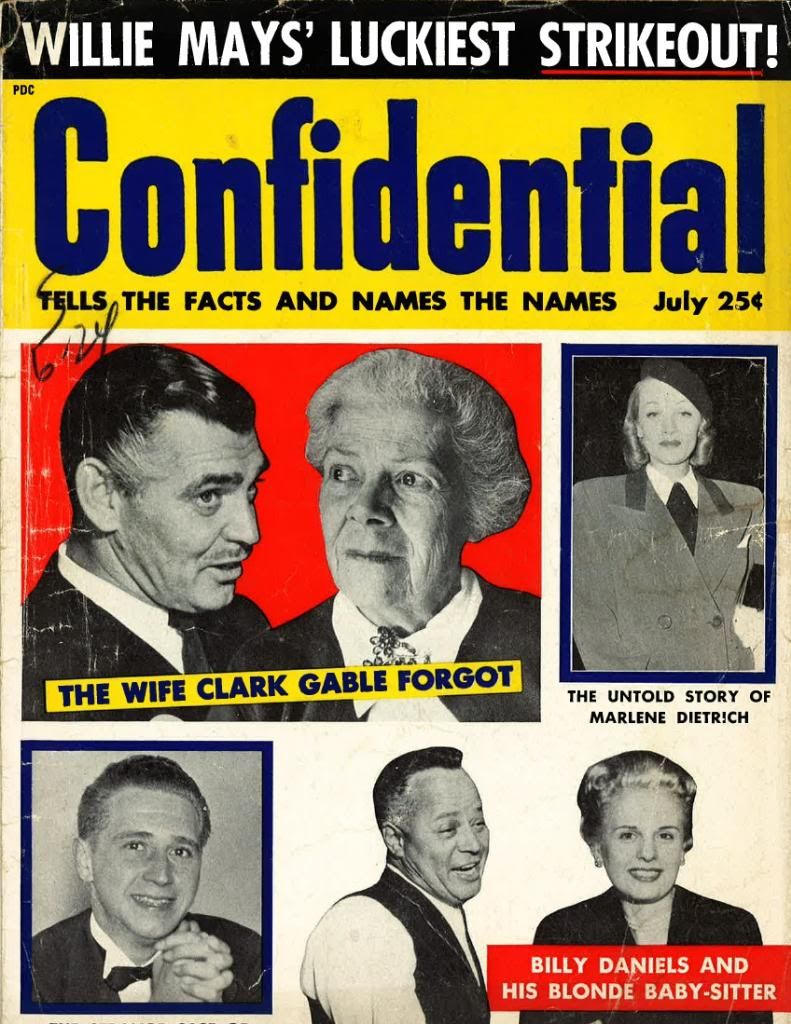
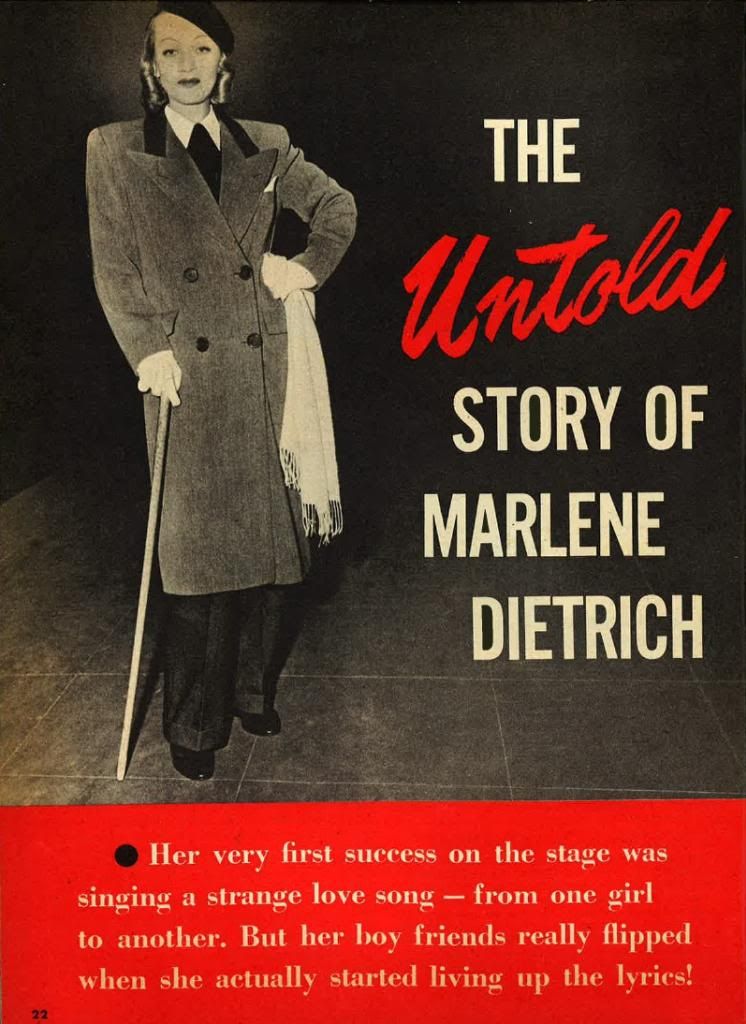
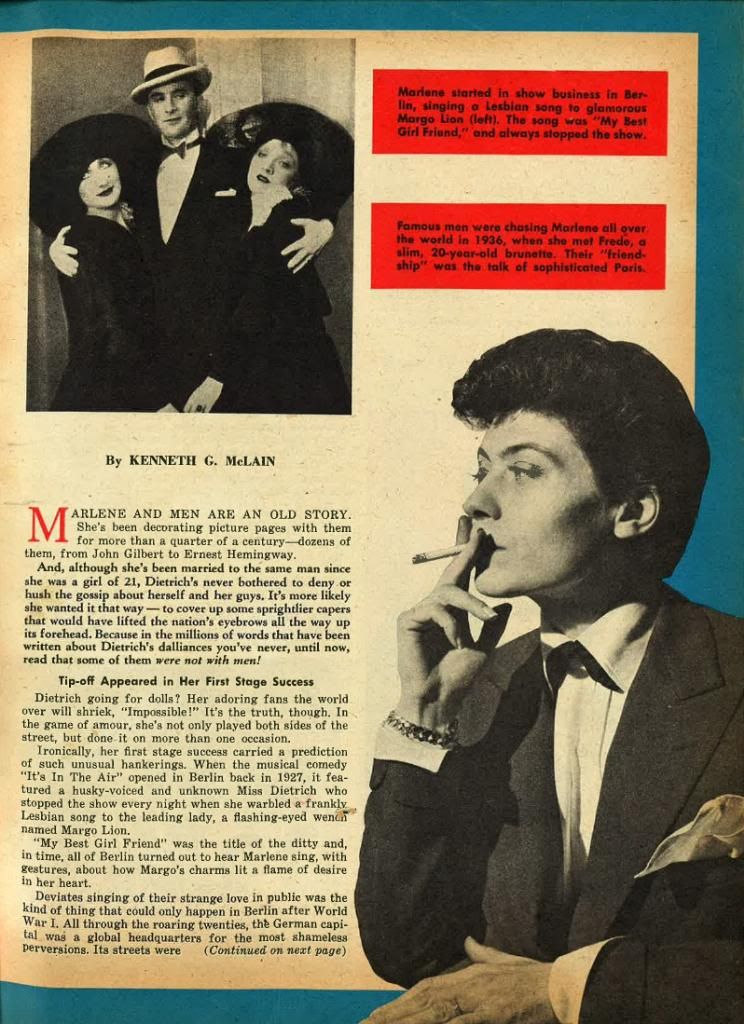

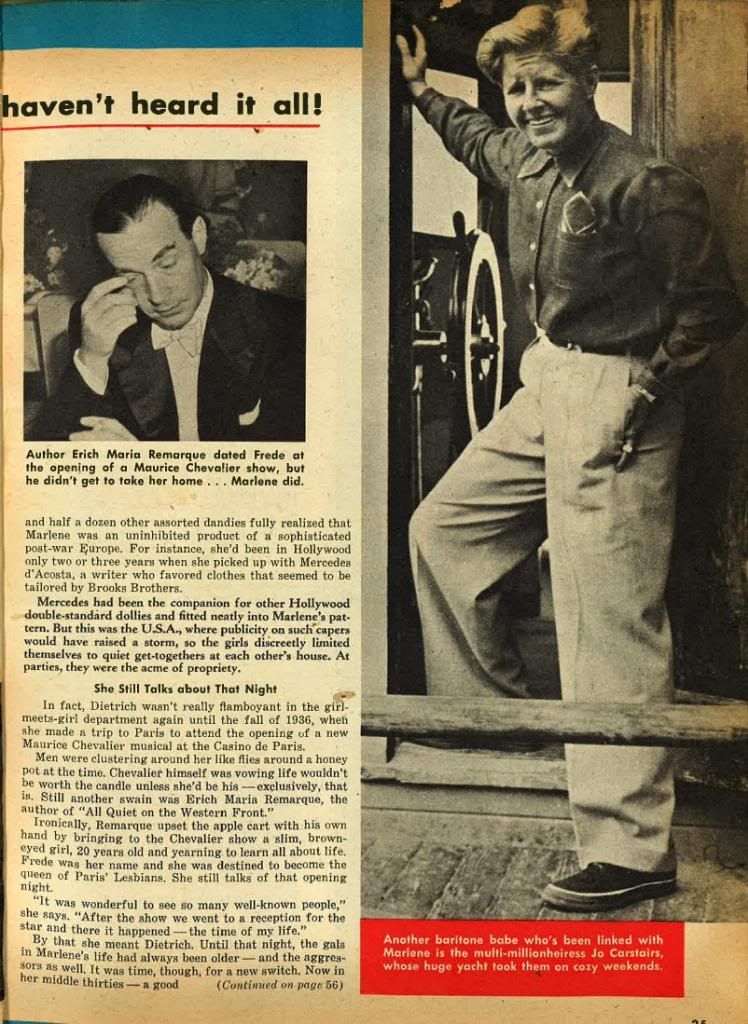

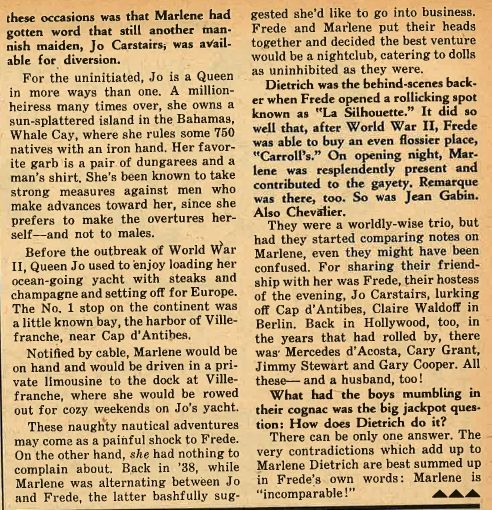
This is glorious! Would you mind terribly if I posted a few of the photos and some of the text on my blog? I'd give you full credit as the source, of course.
ReplyDeleteI'm glad this appeals to you! The article certainly isn't my creative work, and my copyright analysis led me to the conclusion that this content is in the public domain. I would recommend that you research its copyright status, too. If you come to the same conclusion, please feel free to use everything after the jump cut. All I get credit for is the sweat of my brow and the ache in my hands.;)
DeleteI enjoyed reading that,never seen it before,amazing they could get away with printing that in those days.Thank you for bringing it to us.Paul
ReplyDeleteVery interesting!!! you deserve a standing ovation! This magazinbe article is a historical piece to us film buffs that sometimes dont know when something started... I always wondered when the real rumors about Marlene´s sexuality started... and the 50s.. sounds quite good... because the studio system was dying, and gopssip magazines were growing fast...thanks a lot!
ReplyDeleteThanks Joseph!! Amazing, I've read about "the untold story" so often, that I've been very curious about this article, thanks for sharing! I don't support this outing sport either, but it is interesting to read and more elaborated then I expected. I think there never was and never will be anyone who can juggle with lovers like she did, unbelievable! :) Marlene, you're one of a kind!
ReplyDeleteThe photo of Marlene with the walking stick gives me the feeling that Marlene is donning the Josef von Sternbergs style, I think it's this specific coat in combination with the scarf that does it. She looks flawless as always!
Paul, this magazine faced lawsuits from irate stars during its run. Liberace reportedly sued to $20 million because Confidential dared to call him gay. Where would those nasty magazine editors ever get such a ludicrous notion?
ReplyDeleteSerch, you search for the origins of stories, too? We are kindred spirits. I would be very interested to know what lesbian gossip existed about Marlene in German and French that predated this article (such as that German publication mentioned above, which I can't believe was called Herald). I think that you've contextualized the '50s quite keenly. About this particular issue of Confidential, it broke records by selling 3.7 million copies, which indicates an explosive growth. I should mention that the source I'm linking did a beautiful job of citing sources--something one rarely sees on blogs. Among those footnotes, I recognized the name of Mary Desjardins, who was the co-editor of Dietrich Icon.
Karine, I wholly concur! Marlene must be in von Sternberg drag, and it does suit her well.
Merci pour ce document. Savez-vous comment Marlene a réagi à cet article ? Elle a du en entendre parler. Elle prétendait à Bozon qu'elle n'avait jamais eu d'aventures féminines.
DeleteEn France, la presse était plus respectueuse. Même aujourd'hui, le presse à scandale paie des millions d'euros d'amendes, nos lois défendent la vie privée et le droit à l'image est très strict. Nos journaux sont donc plus modérés que chez nos voisins européens.
"Confidential" est connu comme l'ancêtre des magazines "trash" à une époque où les revues avaient encore un rôle de célébration des vedettes.
Although I don't know how Marlene reacted, I too am sure that Marlene knew. She had a lot of eyes and ears that kept her informed, which was apparent in the forward of Leslie Frewin's updated 1967 biography. Frewin's original bio, Blonde Venus, came out in 1955--the year of this Confidential article--and if he's to be believed, Marlene herself and her cohorts hounded him! Of course, an entire book about one's life that contained many interviews is more concerning than a tabloid article with an interview from a relative nobody (Frede), so Confidential may not have been worthy of such a preemptive or retaliatory strike.
DeleteFabrice, have you read about Marlene's lawsuit against Roger Peyrefitte (or read the book that sparked the suit)? I don't know much about it and would be interested to see you write about it on your blog.
Roger Peyrefitte, cette langue de p... vipère ?
DeleteJe n'ai jamais cherché à connaître le passage des "Américains" qui a provoqué le procès et la condamnation de Peyrefitte, car j'ai peu de considération pour ce personnage. Je suis sûr que c'est injuste, ridicule et mesquin. Apparemment, il accusait Marlene d'être versatile et opportuniste en politique.
Il a fait un livre contre les États-Unis, comme il a fait un livre contre les francs-maçons, les juifs, le monde diplomatique, le Vatican... C'était un auteur à scandales et un provocateur stérile.
Mais je vais me renseigner et vous tiendrai au courant.
P.S. Connaissez-vous la chanson des Compagnons de la Chanson "Sacrée Marlène" ? Elle accuse Marlene d'avoir été pro-allemande avant de devenir pro-étasunienne...
Cela ne salit que les auteurs.
Really Marlene was and is "incomparable". Regards
ReplyDeleteOh my gosh. *Droooooool*
ReplyDeleteDas Lila Lied :
ReplyDeletehttp://www.youtube.com/watch?v=2yPakNOVytI
01:26
What terrible English lyrics. It's like "Born This Way" a la cabaret. Thanks for pointing out that Dietrich reference, though!
DeleteThe whole story of Frede is told in the book I just published in France, "Frede" (Les Equateurs editor).
ReplyDeletehttps://www.amazon.fr/Frede/dp/2849904996
I also put on line a site specifically dedicated to this amazing Frede : http://fredebelledenuit.blogspot.fr/
Denis, thank you for sharing! Does your book cite any sources about Frede and Marlene other than the Confidential article?
Delete